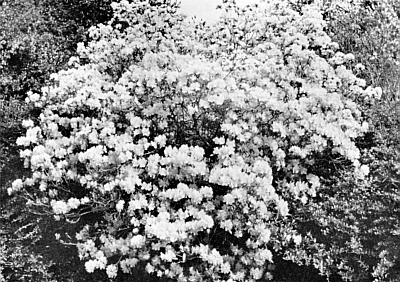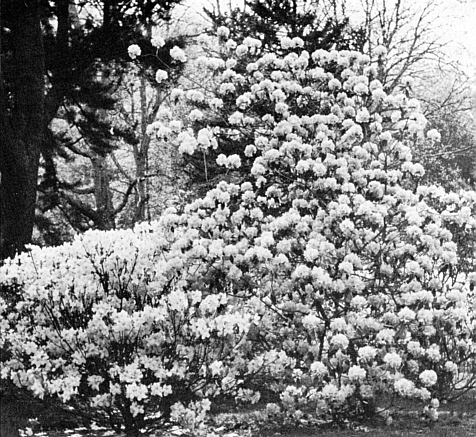LEPIDOTE RHODODENDRONS AT WINTERTHUR
Hal Bruce,
Garden Taxonomist at Winterthur
Of all the various types of rhododendrons, those in the myriad scaly-leaved series have contributed least, in terms of numbers of species, to the landscape at Winterthur. The reasons for this are two: first, not many lepidote rhododendrons really thrive in the climate of the East, and, second, many lepidotes are dwarf, small-flowered plants, ideal perhaps for small gardens or foundation planting, but comparatively ineffective in the grand style of English landscape that is the hallmark of Winterthur.
Not all lepidotes can be so classified, however, Winterthur would be incomparably poorer without the Korean rhododendron (
R. mucronulatum
), which gives us one of our first big displays of color of the year. This hardy deciduous species comes into bloom early in April, with bowl-shaped lavender-mauve blossoms an inch or more wide transforming its upright, leafless branches from bare brown whips to garlands of color. It grows in quantity on the north end of the Pinetum, the mauve forms with pale yellow Corylopsis (Winter-hazel) and the true pink forms with pink and white
Viburnum fragrans
and early Japanese cherries. The long narrow leaves turn a good orange-red in the fall.
About two weeks after
R. mucronulatum
begins, the Japanese
R. keiskei
opens its flowers nearby. This evergreen member of the Triflorum Series has azalea-like flowers of a cool, pale yellow with a touch of chartreuse in it. I have often had visitors ask me where they can obtain this "early green azalea."
R. keiskei
is inter-planted with the lavender Korean azalea,
R. poukhanense
, continuing the color combination of the
mucronulatum
/Corylopsis inter-planting which begins earlier.
Around the first of May the American
R. carolinianum
blooms, with rose-pink flowers nearly two inches broad. This fine evergreen has grown at Winterthur for many years. It is very hardy, and adaptable, so long as the soil in which it grows is sufficiently acid. The form album has flowers of pure white with a yellow-green blotch, and is even more attractive than the type. Both forms grow in the woodlands adjacent to the Museum, where they bloom even in dense shade. Old plants are perhaps eight feet tall and at least as broad, with glossy leaves two to three inches in length.
Its close relative,
R. minus
, is quite similar except that it blooms a full month later. Other minor differences are that it grows larger and on the average has larger leaves and slightly smaller flowers. It is well worth growing, of course, for its late bloom. A large plant of this species grows and blooms well in the deep shade of the Quarry. There is a dwarf form with larger brighter pink flowers collected by Mrs. Mary Henry somewhere in the southern states which is a superlative garden plant. This form grows also in the Quarry. It is an excellent rockery plant.
|
||
|
This about exhausts the list of really showy and useful lepidote species hardy at Winterthur. Some hybrids which are widely used here are Gable's well-known three 'Conemaugh,' 'Conestoga,' and 'Conewago,' which are various combinations of
mucronulatum
,
racemosum
, and
carolinianum
, and bloom in late April in shades of mauve or rosy pink. Gable's 'Pioneer,' an advanced
mucronulatum
-
racemosum
hybrid, is a compact, floriferous plant whose only flaw is its slightly muddied rose color. All these are planted with
mucronulatum
as they bloom slightly later than that species and thus extend the season somewhat. Another hybrid in this area is 'Keiskrac,' a cross of
keiskei
x
racemosum
which bears small light pink flowers. It is intermediate in nearly every way between its two parents, and is an interesting though not very showy plant. 'Ramapo' and 'Purple Gem' are two of Guy Nearing's hybrids of
carolinianum
with
R. fastigiatum
, a dwarf blue of the Lapponicum Series. They are both very compact, small-leaved plants with deep blue-violet flowers. Though not quite as clear in color as such things as 'Blue Tit' and 'Blue Diamond,' they are similar to these cultivars and are of course far hardier. They bloom in early May with Kurume azaleas, but will not tolerate extensive shade.
This list by no means exhausts the lepidotes which have been tried at Winterthur.
R. racemosum
and the very similar
hemitrichotum
grow here but do not make much of a show in the landscape. Species such as
R. imperator
,
yunnanense
,
chryseum
,
impeditum
and
hippophaeoides
have grown for a while in the Quarry but have gradually died out from a combination of summer heat, winter cold with little snow cover, and probably competition from more adaptable plants. They are really specialist's plants in this climate. 'Blue Diamond,' 'Bluebird,' and 'Blue Tit' have also grown with us but failed to flourish. These are just a shade too tender and delicate for our climate.
What the East needs are more hybrids based on
carolinianum
,
minus
, and
mucronulatum
. A pure white, blooming early with
mucronulatum
, would for example be a boon to our gardens, or a hybrid combining the color of
keiskei
with the hardiness, floriferousness, habit and adaptability of
carolinianum album
. We have nothing comparable to the tall blue
augustinii
or the reds, oranges, and apricots of the Cinnabarinum Series, not to mention the glorious things in the series Maddenii and Edgeworthii. All our really adaptable species with the exception of
keiskei
range only from white through pink to rosy purple in color, and the hybrids generally available hardly extend this range.
This is not to say that the Nearing and Gable hybrids mentioned are not good plants in their own right. The same applies to two somewhat newer hybrids which we are testing, 'Dora Amateis' (
carolinianum
x
ciliatum
) and 'Seattle Springtime' (
leucaspis
x
mucronulatum
). The latter is rather tender, but a pretty little early-blooming blush white. 'Dora Amateis' is already fast becoming a popular garden plant. One still thinks of them, however, as steps on the way rather than the goal itself. We don't have a hardy 'Lady Chamberlain' or 'Saffron Queen,' even with the work of David Leach, Edmond Amateis, Joseph Casdevall, and Donald Hardgrove. At least not yet.
I have reserved final mention for a lepidote hybrid which in many ways is the finest in commerce: the cross of
carolinianum
and
dauricum
called variously 'P. J. Mezzitt' or 'P. J. M'. This is a shapely, trouble-free, fully evergreen shrub which produces in late April large trusses of rich purple flowers. Almost as appealing as its flowers are its leaves, which in winter turn bronze-purple, gradually becoming green again as spring advances. Planted among a ground-cover of the pale silvery-blue Spring Starflower (
Ipheion uniflorum
), as it is at Winterthur, it makes a really arresting sight in landscape of early spring.

